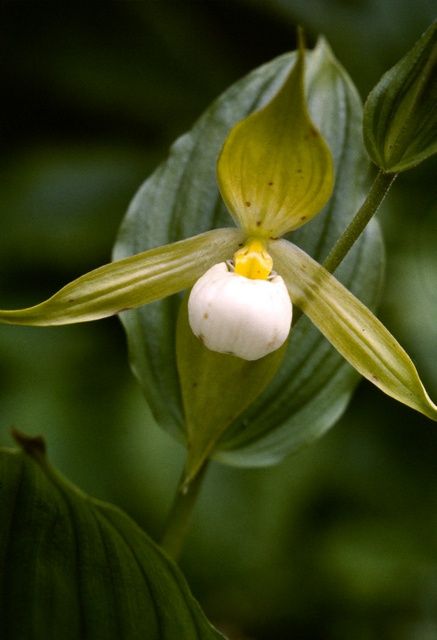
C. cordigerum D. Don, Prodr. Fl. Nepal: 37 (1825). Type: Nepal, Gossainthan, Wallich s.n. (holo. BM!).
Plant 22-60cm tall; rhizome short, stout. Stem solitary, slender to stout, increasingly pubescent and glandular from base upwards, up to 55cm long and 3-8mm in diameter; basal tubular sheaths 3-4. Leaves 2-5, distant along stem, elliptic to broadly elliptic, acute to acuminate, glabrous above and below, sparsely ciliate on the lower margins, 8-18 x 3.5-10.5cm. Inflorescence l-flowered; peduncle 4-15cm long; floral bract leaf-like, elliptic to lanceolate, acuminate, pubescent on veins of lower surface, ciliate, 6-9 x 1.5-4cm. Flowers variable in size; sepals and petals green or pale green (rarely white or pale yellow), lip white spotted with pink within, staminode yellow with red spotting; pedicel and ovary densely glandular, 3-4cm long. Dorsal sepal lanceolate, acuminate, pubescent at base on inner side and on outside, ciliate towards apex, 1.4-2cm wide; synsepal narrowly elliptic, with 2 free acuminate tips, pubescent on outside, ciliate, 3.5-5 x 1-1.7cm. Petals lanceolate or linear, tapering above, acuminate, pubescent at base, 2.8 x 0.5-i.icm. Lip slipper-shaped, porrect, somewhat ellipsoid or globose, dorsi- ventrally flattened, with a small mouth, 2.5-3.5cm long; lateral lobes infolded and creased. Column 1-1.5cm long; staminode oblong to trowel-shaped, obtuse, slightly longitudinally concave, glabrous, c.9 x 5mm. Plate 1.
Bhutan: C - Ha (Damthang, Tare La), Thimphu (Chanana), Punakha (Phobsikha, Wangdi Phodrang (field record)) and Bumthang (Shabjetang to Bumthang Chu, Lami Gompa, Ura La to Byakar, Yuto La) districts. Chumbi (Yatung). In wet and shady woods, open Abies, Picea, Pinus wallichiana and Tsuga forest, on outskirts of forest or in open glades, in Caragana, Juniperus and dwarf bamboo scrub, on S-facing slopes; 2100-4000 m. Fl. May-August.
general distribution. W Himalayas, through Kashmir, N India, Nepal to China (Xizang). etymology. From the Latin torch- (heart-shaped) and gero (to carry, bear).
note. C. cordigerum is readily distinguished from other Asiatic species by its distinctive green and white flower, borne at the apex of a long, glandular peduncle and pedicel, and the deeply divided apex of the synsepal.


